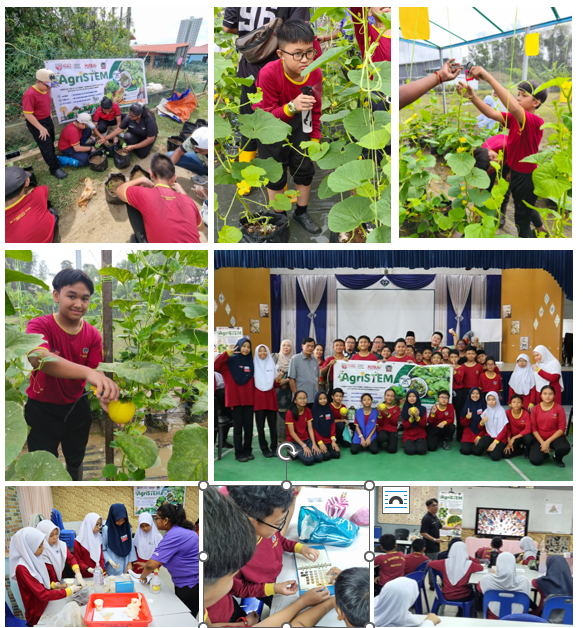Agriculture is more than just food production, it is a fundamental pillar of the economy, especially in developing and emerging nations. It plays a crucial role in ensuring food security, creating employment, and supporting rural development. In Malaysia, the agrofood sector plays a significant role in supporting Malaysia’s economy, contributing 11.6% to the national GDP and employing 1.87 million people in 2023 (approximately 10% of the total Malaysian workforce). According to the World Bank Group, agriculture alone accounts for 26.5% of employment worldwide, and in low-income countries, that figure can exceed 50%. It also supports various sub-sectors including agro-processing, logistics, biotechnology, research and development, agrotourism, and creating value across supply chains.
Ageing Farmers a Worrying Trend
However, in recent years, global agriculture has been facing a critical demographic challenge where fewer young people are entering farming, while aging farmers continues to rise. This growing gap threatens the sustainability of food systems and rural economies. According to the Food and Agriculture Organization (FAO), the average age of farmers worldwide is over 60 years. In Malaysia, 45.6% are aged over 60, 32.3% are between 46 and 59 years old, and only 22.2% fall between the ages of 15 and 45. Even in Japan, a country known for technological advancement in agriculture, more than 65% of farmers are over 60. This global trend paints a clear picture where agriculture is growing old, and the next generation is not stepping in fast enough. The question is why?
The Challenges: A Crisis of Perception
The main challenge lies in how agriculture is perceived. For many young people today, farming is still associated with physical labour, poverty, and hardship. It’s often seen as a “last resort” career one without prestige, or a stable income. This outdated image does not align with the aspirations of a generation raised in the digital age. Most youths dream of careers in medicine, engineering, or business. Agriculture rarely makes the list, despite being the backbone of food security and a growing sector in agri-tech innovation. As a result, students avoid agriculture-related courses in school or university, and rural youth abandon family farms for city jobs even if those jobs are low-paying and unstable.
Another contributing factor is urbanization. With more young people moving to cities for education and employment, rural areas are losing their potential change-makers. City life promises connectivity, career growth, and comfort, while farming seems isolated and slow-moving in comparison. This migration creates a talent vacuum in the agricultural sector, where traditional knowledge is lost and new innovations are slow to reach small-scale farms.
For those youths who are interested in farming, access remains a major barrier. Land is expensive or inherited, capital is hard to secure, and training opportunities are limited. Most youth don’t have the means to buy farmland, invest in machineries, or develop agri-based startups. There’s also limited exposure to modern farming techniques in the school system. Without strong mentorship or institutional support, even motivated youth find it difficult to turn agriculture into a viable career path.
Agriculture Is Changing but Youth Don’t Know
The agriculture today is undergoing a technological transformation. Smart farming, AI-powered precision agriculture, and climate-resilient crops are reshaping the way food is produced. But many youths are unaware of these advancements because of the lack of exposure in mainstream education and media. To change the trend, we must first change the narrative. Agriculture must be presented not just as a job, but as a solution space, a field where young people can become innovators, scientists, entrepreneurs, and sustainability champions. Youngsters have more advantages in agriculture because they can quickly grasp and adopt new technologies, which helps modernize and transform the sector.
Initiatives like AgriSTEM- the integration of agriculture with education are the key. By integrating agriculture into science, technology, engineering, and mathematics, such programs help youths see farming in a new light as smart, modern, and essential. AgriSTEM is not just about learning how to grow food. It is a holistic, interdisciplinary educational model designed to reframe agriculture in the minds of young people as a smart, scalable, and innovative field with real economic value.
Integrating STEM in Agriculture from Early Education
Introducing AgriSTEM from primary school itself, we can reshape this perception and inspire students to see agriculture as a modern, high-tech, and impactful field. AgriSTEM programs are built on hands-on, experiential learning that merges classroom theory with practical fieldwork. When introduced early even from primary school, students start building curiosity, scientific thinking, and a connection to the soil from a young age. This includes:
SCIENCE: Primary students can explore basic plant biology, soil compositions, and nutrient cycles through simple experiments like growing seedlings, testing different soils, or observing insects in the garden.
Importance: Early exposure builds a strong scientific foundation and sparks a lifelong interest in natural sciences.
MATHEMATICS: Young learners can practice basic calculation by measuring fertilizer and pesticide dose, plant growth, counting seeds, or planning small school garden plots.
Importance: These activities make abstract math concepts concrete and meaningful.
ENGINEERING: Students can engage in creative building projects, such as designing mini nethouse structure, DIY hydroponics with recycled bottles, or constructing compost bins.
Importance: Engineering activities cultivate problem-solving and design skills early on.
TECHNOLOGY: Even at the primary level, students can learn to use simple sensors to measure temperature and moisture or observe how drone application in farming activities.
Importance: As they progress, they can be introduced to coding small devices or using tablets for farm record-keeping.
Cultivating Future Changemakers
These STEM elements are not taught in isolation but integrated into real-life agricultural contexts, so students understand how each piece connects to food, community, and the environment. This helps them see agriculture as a dynamic system that requires creativity, innovation, and teamwork. Through AgriSTEM also students are encouraged to think critically, ask questions, design solutions, and work collaboratively. Imagine a primary school where children plan a vegetable plot, experiment with organic fertilizers, or make compost from school canteen waste. These activities not only sharpen their innovation and problem-solving skills but also build leadership, communication, and digital literacy.
Moreover, early AgriSTEM education teaches students about sustainability, climate resilience, and food security, making them more environmentally conscious and community-minded from an early age. They learn to appreciate the value of food, the effort behind it, and the importance of conserving resources. Perhaps most importantly, AgriSTEM transforms agriculture from a fallback option into an aspirational and respected career path. By merging business thinking and STEM into agriculture, we help young people see farming as profitable, innovative, and vital for national and global well-being.
Spotlight on AgriSTEM @ SK Kampung Baru Bintulu
The AgriSTEM Program, led by Universiti Putra Malaysia Sarawak (UPMS), represents an innovative approach to integrating agriculture into STEM (Science, Technology, Engineering, and Mathematics) education. This program implemented over a year at Sekolah Kebangsaan Kampung Baru, the program engaged 40 STEM Club students through four structured modules centred on golden melon cultivation using modern agricultural techniques. The modules are:
Module 1- introduced theoretical knowledge of crop management, focusing on the scientific aspects of golden melon production.
Module 2- provided hands-on experiments in calculating seed germination rate, determining fertilizer dosage, correcting soil pH, and identifying common pest by integrated science and mathematical concepts.
Module 3- emphasized practical skills by engaging students in planting 200 golden melons plants in nethouse equipped with dripping system, highlighted engineering and technology principles and regular crop management practices.
Module 4- concluded the program with harvesting activities, and comprehensive data collection on fruit production. Additionally, students explored value-added product development, such as creating melon-based ice cream and dadih, which cultivated entrepreneurial skills
Students responded enthusiastically to the hands-on AgriSTEM experience, shifting from initial hesitation to excitement. Initially, 80% rated their interest in agriculture at just 2 or 3, with only 32.5% genuinely enthusiastic. After the modules, students described agriculture as “fun,” “exciting,” and “cool,” recognizing it as a dynamic field combining science, technology, and innovation. In the post-program survey, 82.5% rated their enthusiasm at 4 or 5, reflecting a strong positive shift in perception and engagement toward modern farming.
With plans for the next planting cycle, the school expressed strong support, recognizing the program’s potential to nurture STEM-literate, agriculture-aware students and promote agriculture as a viable business.
UPMS deeply appreciates the incredible support given by the school’s PIBG, headmaster, school management, and STEM teachers for their unwavering commitment and collaboration in making this AgriSTEM initiative a success.
 Young learners explore the planting journey with curiosity and joy
Young learners explore the planting journey with curiosity and joy
AgriSTEM Education Should Not Be Confined to School Walls; It Should Extend into Homes
The impact of AgriSTEM becomes even more meaningful when parents are actively involved. Parents play a crucial role as role models and mentors. By participating in AgriSTEM activities, they not only support their children’s learning but also strengthen family bonds and encourage lifelong learning. When parents understand what their children are learning at school, such as seed germination, soil mixing, crop planting, or pest management, they can reinforce these lessons at home through shared gardening or small-scale farming projects.
Applying AgriSTEM knowledge at home turns everyday activities into valuable learning opportunities. Families can start a small vegetable garden in the backyard, set up potted herbs on the balcony, or build simple composting systems together. These practical activities help children see the real-world relevance of what they learn in class, deepen their understanding, and build confidence in applying new skills. When families work together to grow their own food, they also develop a greater appreciation for agriculture and the effort behind every meal. This shared experience nurtures respect for farmers and promotes healthier, more sustainable food choices.
Sowing the Future
The goal is simple yet profound to cultivate not just crops, but future changemakers. By planting the seeds of curiosity, innovation, and resilience in young minds today, we are nurturing the farmers, scientists, engineers, and entrepreneurs of tomorrow. To secure the future of food, we must start by investing in the future of farmers and that journey begins in primary school classrooms. Each lesson is a seed; each experiment is a sprout of potential. When children learn to observe a tiny seed break through the soil, they also learn about patience, perseverance, and the power of growth.
Through AgriSTEM, these seeds of learning blossom into a deeper understanding of sustainability, climate challenges, and food security. They start to understand that feeding the world is not only a necessity but a noble mission that demands intelligence, creativity, and compassion. In this way, we are not merely teaching agriculture, we are planting seeds of hope, resilience, and ingenuity. And as these seeds grow, they will bear fruit for generations to come, ensuring a healthier, more sustainable, and more equitable food system for all.
“We don’t just plant seeds in the soil, we plant ideas in young minds
to grow future innovators”
By Shiamala Ramaiya
Department of Crop Science, Faculty of Agricultural and Forestry Sciences
Universiti Putra Malaysia Sarawak
Date of Input: 11/07/2025 | Updated: 11/07/2025 | lanz
MEDIA SHARING











 Young learners explore the planting journey with curiosity and joy
Young learners explore the planting journey with curiosity and joy




















